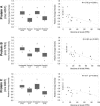Decreased levels of CXC-chemokines in serum of benzene-exposed workers identified by array-based proteomics
- PMID: 16286641
- PMCID: PMC1288009
- DOI: 10.1073/pnas.0508573102
Decreased levels of CXC-chemokines in serum of benzene-exposed workers identified by array-based proteomics
Abstract
Benzene is an important industrial chemical and environmental contaminant that causes leukemia. To obtain mechanistic insight into benzene's mechanism of action, we examined the impact of benzene on the human serum proteome in a study of exposed healthy shoe-factory workers and unexposed controls. Two sequential studies were performed, each using sera from 10 workers exposed to benzene (overall mean benzene air level >30 ppm) and 10 controls. Serum samples were subjected to anion-exchange fractionation and bound to three types of ProteinChip arrays (Ciphergen Biosystems, Fremont, CA) [hydrophobic (H50), metal affinity (IMAC3-Cu), and cation exchange (WCX2)]. Protein-expression patterns were detected by surface-enhanced laser desorption/ionization (SELDI)-TOF MS. Three proteins (4.1, 7.7, and 9.3 kDa) were consistently down-regulated in exposed compared with control subjects in both studies. All proteins were highly inversely correlated with individual estimates of benzene exposure (r > 0.75). The 7.7- and 9.3-kDa proteins were subsequently identified as platelet factor (PF)4 and connective tissue activating peptide (CTAP)-III. Initial proteomic results for PF4 and CTAP-III were subsequently confirmed in a single experiment using a ProteinChip-array-based immunoassay(Ciphergen Biosystems). The altered expression of the platelet-derived CXC-chemokines (40% and 63% for PF4 and CTAP-III, respectively) could not be explained by changes in absolute platelet counts. Thus, SELDI-TOF analysis of a limited number of exposed and unexposed subjects revealed that lowered expression of PF4 and CTAP-III proteins is a potential biomarker of benzene's early biologic effects and may play a role in the immunosuppressive effects of benzene.
Figures



References
-
- Aksoy, M. (1985) Am. J. Ind. Med. 7, 395-402. - PubMed
-
- Austin, H., Delzell, E. & Cole, P. (1988) Am. J. Epidemiol. 127, 419-439. - PubMed
-
- Hayes, R. B., Yin, S. N., Dosemeci, M., Li, G. L., Wacholder, S., Travis, L. B., Li, C. Y., Rothman, N., Hoover, R. N. & Linet, M. S. (1997) J. Natl. Cancer Inst. 89, 1065-1071. - PubMed
-
- Savitz, D. A. & Andrews, K. W. (1997) Am. J. Ind. Med. 31, 287-295. - PubMed
Publication types
MeSH terms
Substances
Grants and funding
LinkOut - more resources
Full Text Sources
Other Literature Sources
Medical
Miscellaneous

